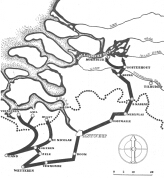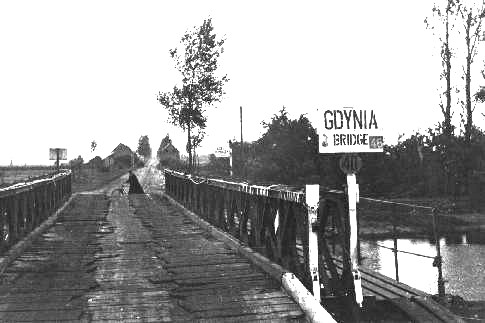|
Short summary out of "the Victory Campaign" by colonel C.P. Stacey.
While the Army Commander was issuing orders for a regrouping, the 1st Polish Armoured Division was already clearing the 712th German Infantry Division out of the remainder of the pocket formed by the river Scheldt and the Ghent-Terneuzen Canal.

click on map to enlarge
The terrain was very unsuitable for armour. The area south of the Scheldt, a large portion of which lay below sea level, was a maze of canals and rivers. Although existing roads were in good condition, they had been built on narrow embankments, bordered by trees, providing admirable defiles for defensive fire. The enemy's inundations and cleverly camouflaged defences, covering open spaces between obstacles, set a formidable task for the Polish troops.
During 12-14 September General Maczek's men had cleared the suburbs of Ghent and pushed north-east in the face of increasing resistance.
On the 15th the Poles concentrated at the village of St. Paul a few miles north of St. Nicolas on the main Ghent-Antwep lateral road and prepared to force the Axel-Hulst Canal in the direction of Terneuzen. The latter was a port of some importance on the Scheldt, the northern terminus of the Ghent-Terneuzen Canal.

Monument of the Dragoons in the bridgehead just after the war.
Crossing the Dutch frontier, the 10th Dragoon Regiment captured a small bridgehead over the Axel-Hulst Canal, between Axel and Hulst, on the 16th. However, the Germans counter-attacked furiously with armoured support early on the 17th and wiped out the bridgehead with heavy losses to the Poles.
Next day, nevertheless, the Poles attacked again. Their 3rd Infantry Brigade established a strong position across the canal near Kijkuit. By dawn of the 19th their sappers had completed a baily bridge. The brigade then expanded its bridgehead rapidly and occupied the neighbouring town of Axel only five miles from Terneuzen.

Gdynia Bridge constructed by Polish Sappers.
The Poles were now poised for the final advance. On the morning of the 20th they reached the estuary of the river Scheldt at several points and sank or captured many craft that had heen used by the Germans to evacuate their forces across it. Later in the day Terneuzen fell to the Polish 3rd. Brigade.
By the 22nd the division had systematicaIly mopped up all remaining resistance.
Polish casualties during the period 10-22 September were reported as 75 killed, click here for details 191 wounded and 63 missing.
German prisoners, captured by the division totalled 1173.
The situation now was that the enemy had been cleared from the south bank of the West Scheldt, but only as far as the inlet just west of Terneuzen.
The Poles got a short rest in Northern Belgium. The next job was to liberate [Merksplas and surroundings]
A very detailed description of this battle is to be found in a Dutch book with the title: De maand der bevrijding composed by P.G. van den Bosse, printed september 1975 at Axel.
In K. Jamar's book titled With the tanks of the 1st Polish Armoured Division, published in 1946 by H.L. Smit & Zn. at Hengelo, the Netherlands, you'll find a report about these battles.
|


